ROBERT ABELL describes the making of the Atlantic cable laying feature for the BBC Coast programme
A bit of background
Brunel’s Great Eastern needs no introduction to most people, as this colossal vessel completed in 1860 and years ahead of her time, was intended to be able to make the round voyage from Britain to Australia carrying 4000 passengers for the emigrant trade without refuelling. Completed in 1859, the ship was never used on that intended service and made several voyages to America followed by a rather chequered history, before she was finally broken up in 1889. Her greatest achievement was laying the first successful transatlantic telegraph cable in 1866, which brings me to the subject of this article.
Enjoy more Model Boats Magazine reading in the monthly magazine.
Click here to subscribe & save.
The first cable laid by the Great Eastern was in 1865 and that must have been an absolute nautical nightmare for all concerned. The ship departed Valentin in County Kerry on 25th July 1865, but after only a few hours the cable was discovered to be damaged and at first, sabotage was suspected. The cable was then repaired and the journey continued, but two days from Newfoundland, there was a winch mishap and the cable snapped leaving it at a depth of 1.25 miles. The weather was too bad for the crew to retrieve it, so the position was marked with a buoy in the middle of the Atlantic Ocean and Great Eastern sailed home. In 1866, a year later and after sufficient new funds had been raised, the ship left Ireland again with more cable plus grappling gear, and managed to find the marker buoy which was truly amazing. Remember, there was no global positioning system or radar at that time! A good historical source said that Great Eastern actually ran into the buoy during the night.
The water was so deep that it took the tandem grappling hooks, each with five prongs, two hours to reach the sea bed. However, with a miracle they found the sunken cable, but it was so heavy that a grappling wire snapped three times, losing more cable and equipment on each occasion. The winches were also severely damaged and had to be repaired, the blacksmiths working at a forge on the open deck. Nevertheless, the cable was finally retrieved, spliced and Great Eastern reached her final destination of Hearts Content in Newfoundland. The joining of Europe and America by telegraph at that time was probably the first ‘Giant Step for Mankind’.
Queen Victoria was able to send a message to Andrew Jackson, the American President, which took several hours to transmit by Morse Code. Previously, it would have taken several weeks getting there by ship and a similar time for the reply to return.
Great Eastern’s cable laying days were over by 1872 and she then spent just over 12 years in Milford Haven. In 1885 she moved to Liverpool and was then broken up at Rockferry commencing in 1888, this itself taking two years.
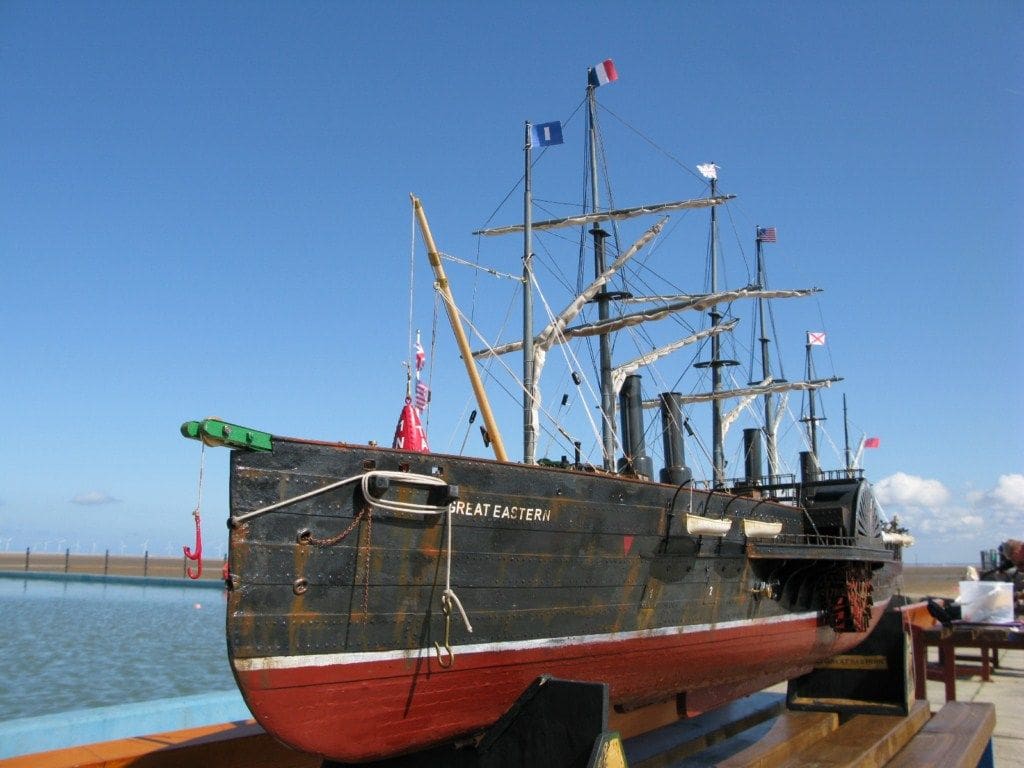
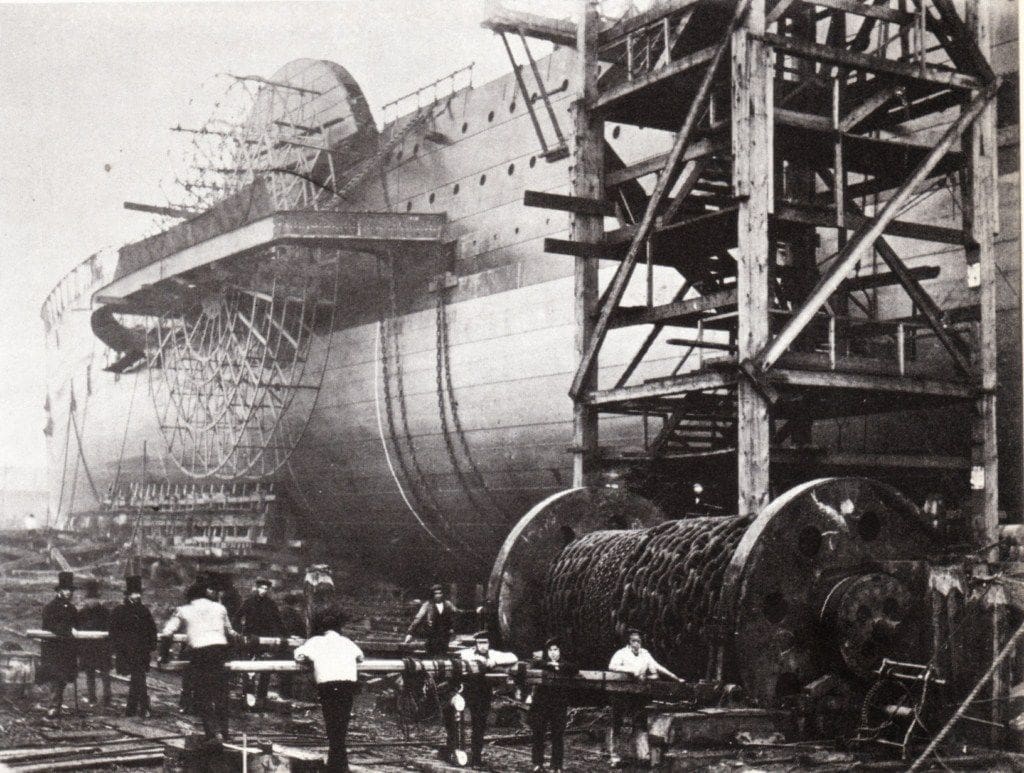
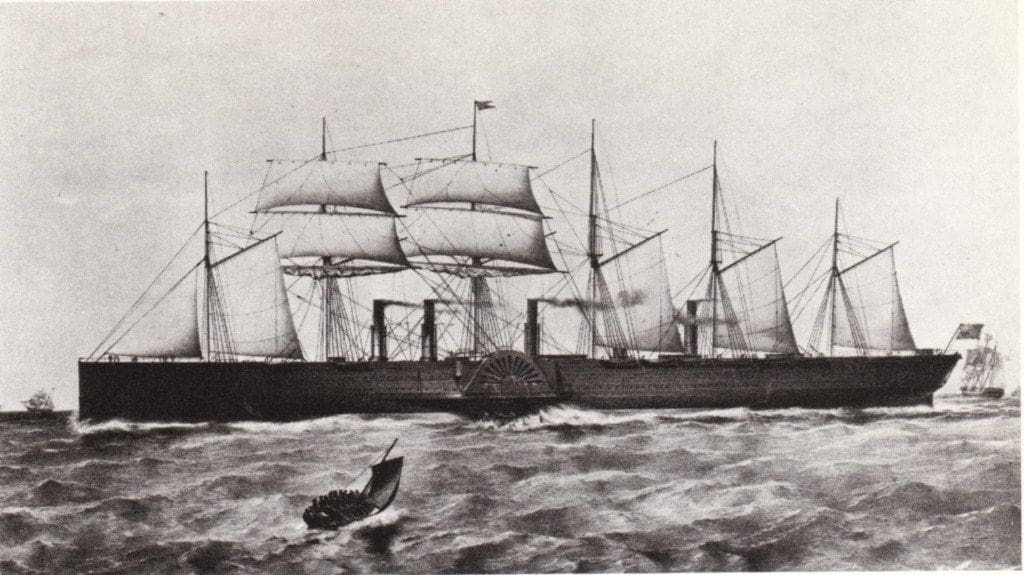
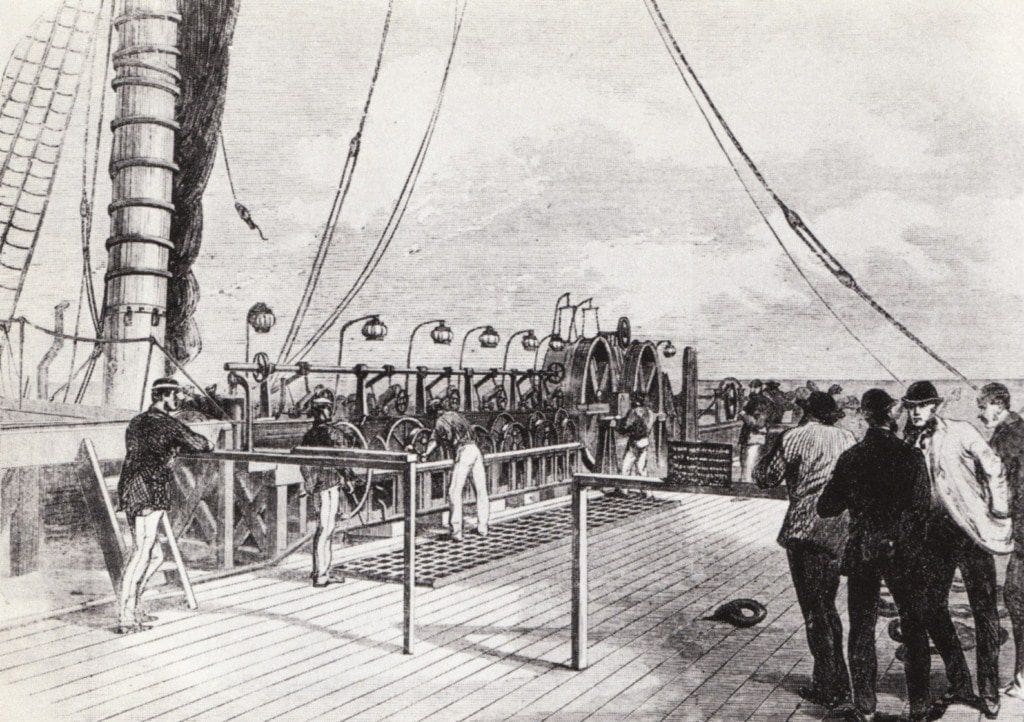
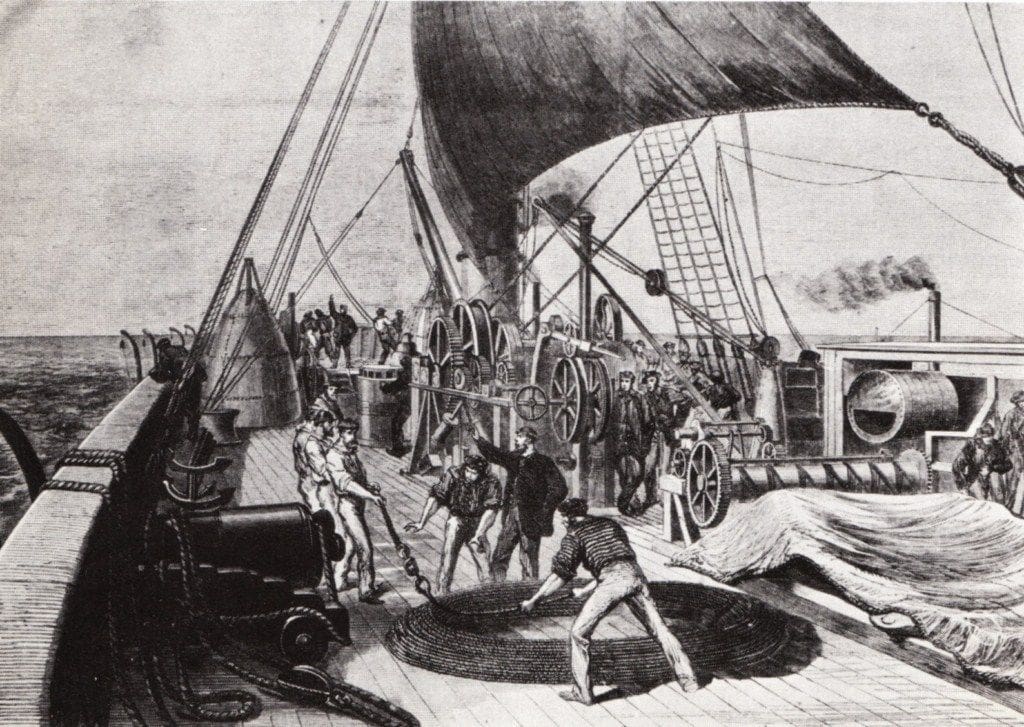
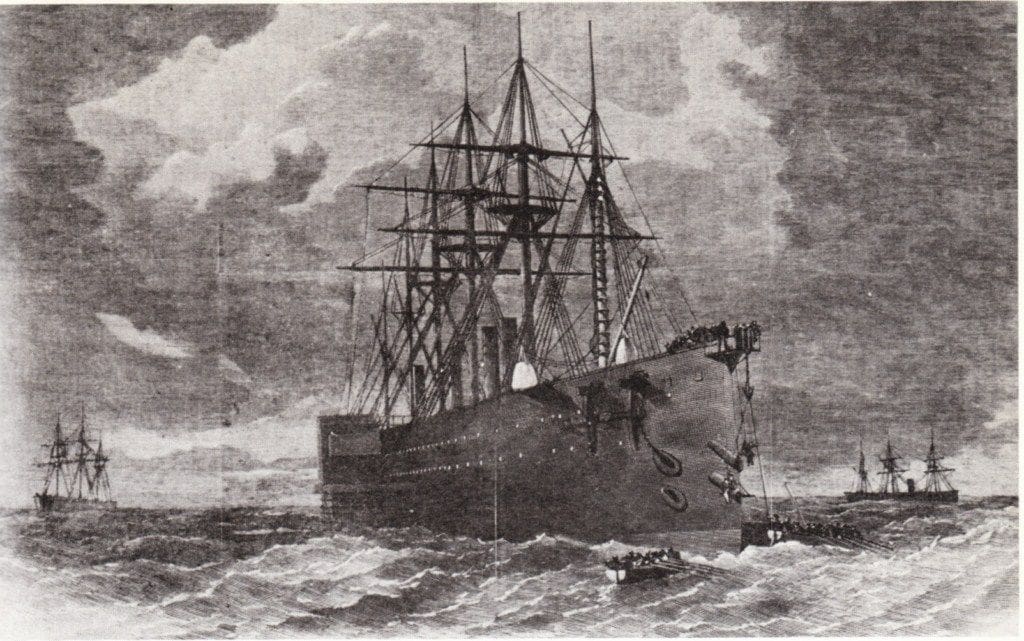
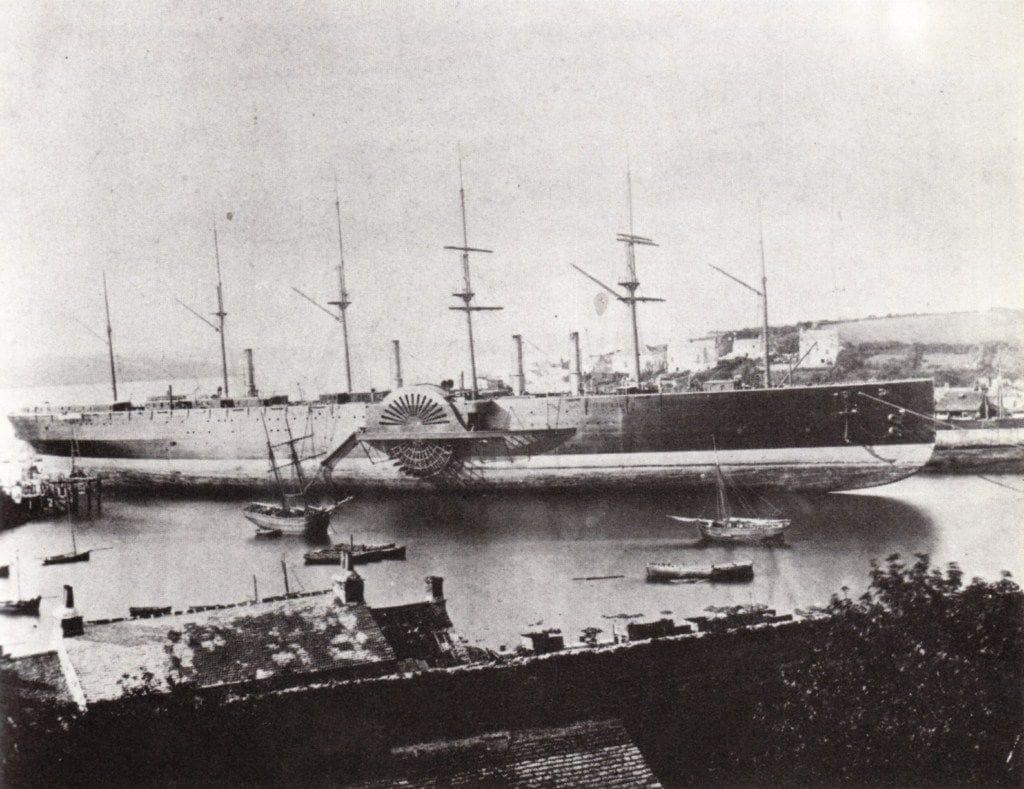
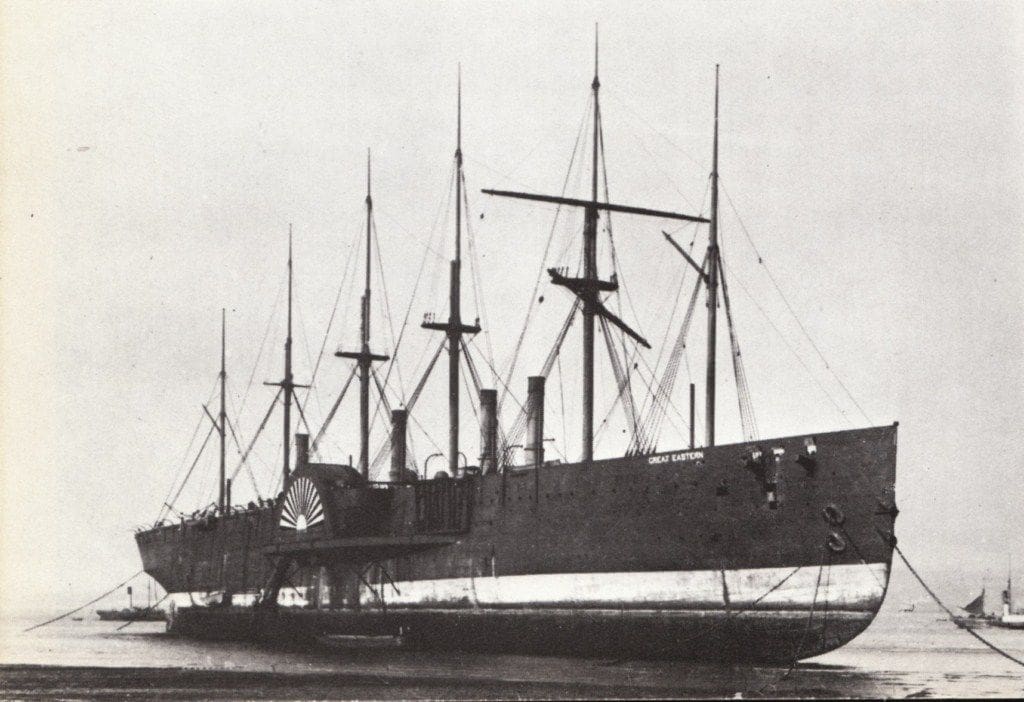
Origin of the television project
In April 2011 I was contacted by Colin Bishop who had been made aware by Paul Freshney that the BBC Coast TV programme were looking for a model of Great Eastern to feature in an item they were planning for a practical demonstration in miniature of the first transatlantic cable laying. My model of Great Eastern had previously featured in the December 2008 issue of Model Boats and its construction was described on the Model Boats Website Forum and Colin felt that it was just what the BBC were looking for.
After some trepidation I agreed to explore the possibility, and on seeing photos of the model and reading my build postings on the forum, the BBC team became enthusiastic to proceed with the project. The basic idea was to use the model to ‘lay’ a cable across a boating pond representing the Atlantic and then to transmit a simple message from one side to the other using the sort of equipment which was in use in the 1860’s.
The MB Website Forum topic was very useful to the BBC staff as they could read ongoing posts and then discuss the project over the phone and it also allowed the Forum members to add their own constructive comments.
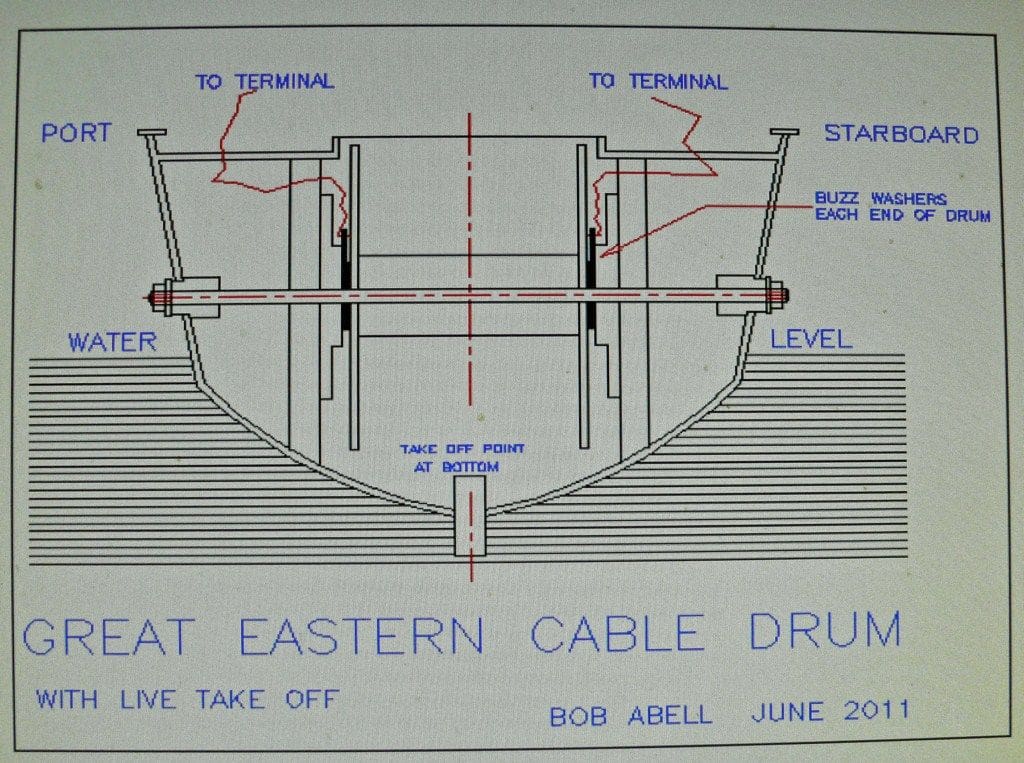
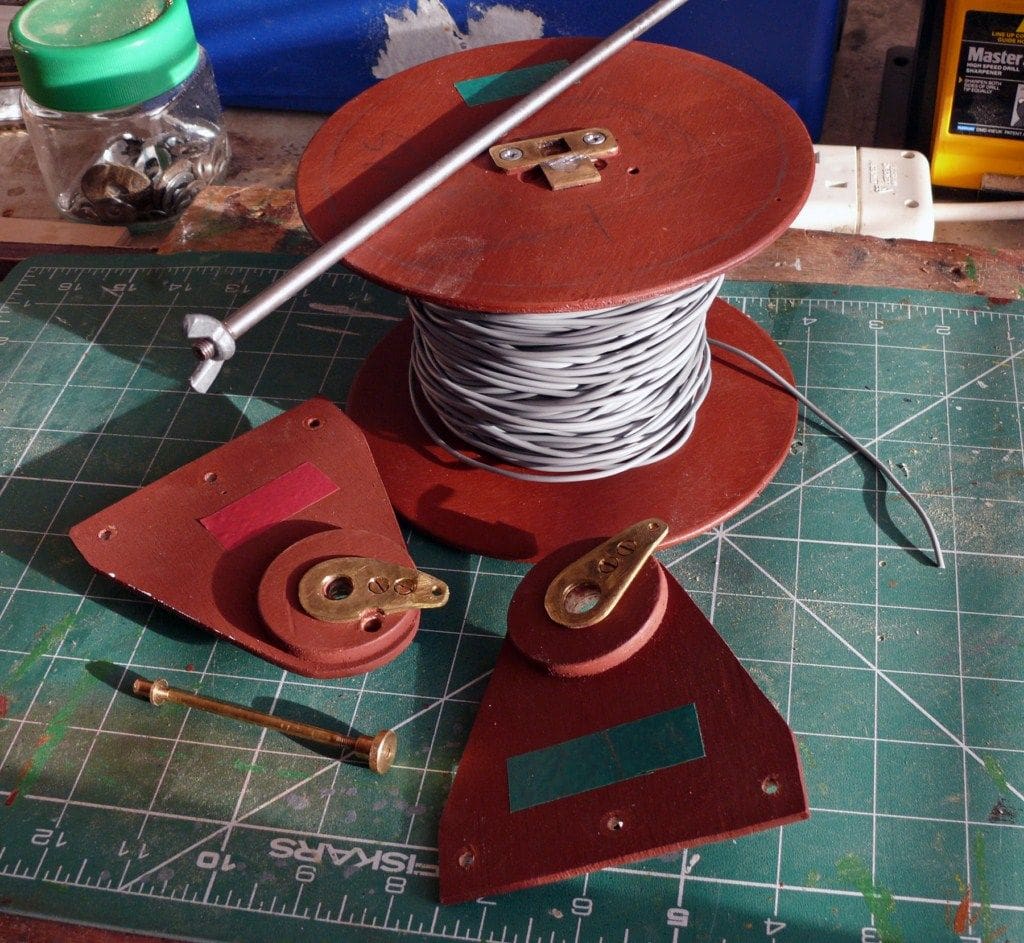
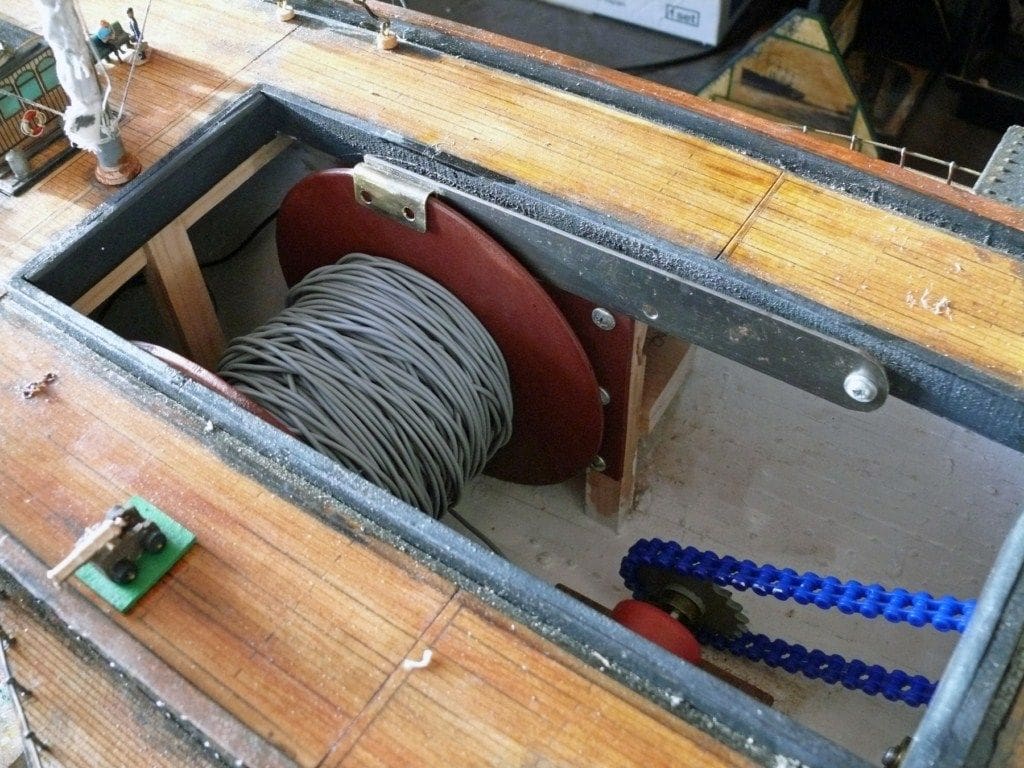
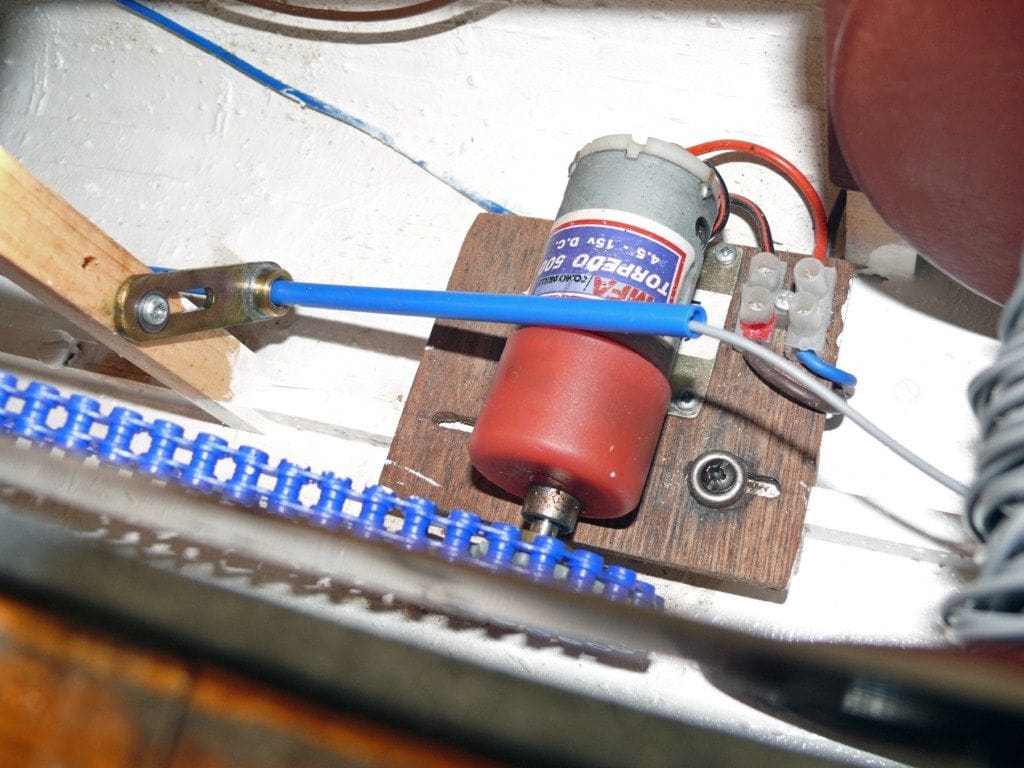
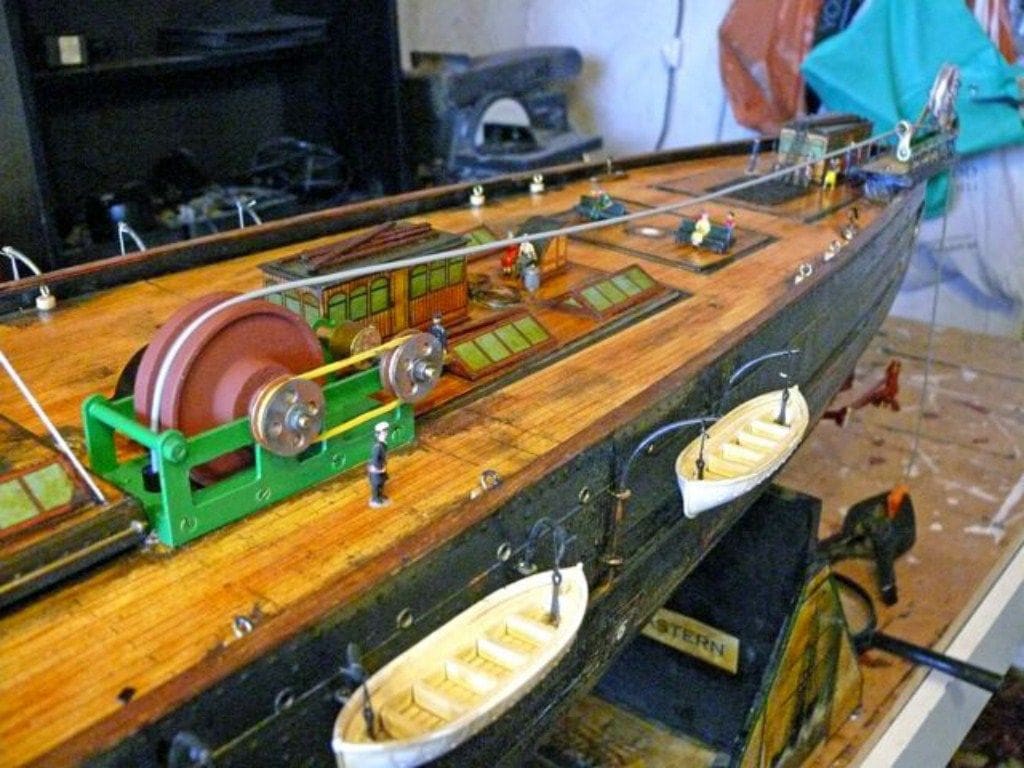
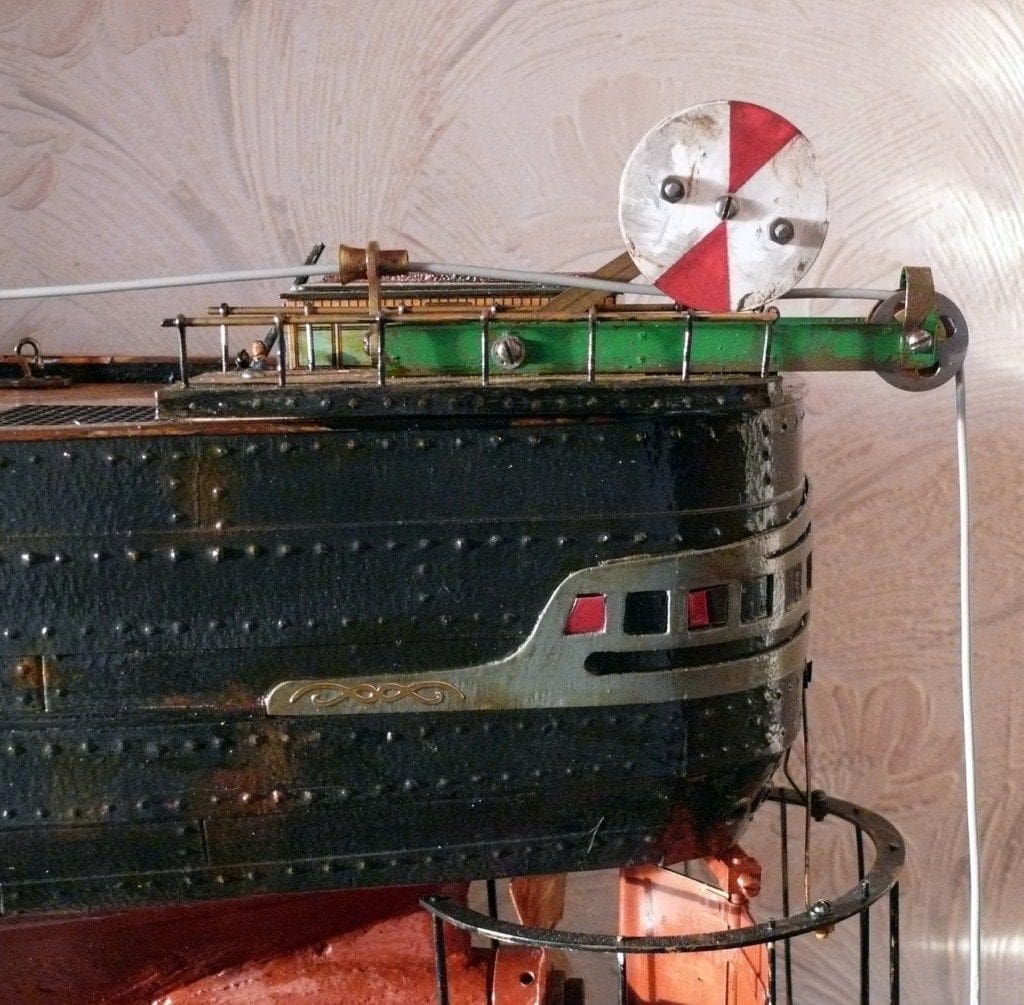
Project considerations
We started with a blank piece of paper! The questions to be answered were numerous, including:
What type of cable?
How long would it need to be?
What do we need at each end of the cable?
Where could the cable drum be mounted in the model?
Could the drum hold enough cable?
How to get the cable through the inside the hull, avoiding existing wiring and the drive motors and paddle chain drives etc?
Where would the cable emerge from the stern?
These were questions needing answers and there was only one month to get it all resolved, which was the real killer. Fortunately, filming was put back to August 2011 (and eventually October) which allowed more time for modifications to the model and thus the work slowed to just a fast gallop.
An MB Website Forum member pointed out that number four funnel was removed to make way for cable loading access on the full size vessel, so this was duly removed from the model and capped, a vital modification that was essential for authentic filming. Back in 1865/1866, the total length of cable required was actually delivered to Great Eastern in batches whilst she was in mid-Atlantic and spliced on board. To facilitate this, a special splicing frame was built on the ship, as the deadweight of the suspended cable must have been enormous.
Internal model alterations
The cable drum for the model was drawn out using computer aided design (CAD) and when constructed it fitted into the hull space quite easily. It could accommodate about 200m of cable, but 100m was found to be enough for the task. Special care was necessary when winding the cable on to the drum to avoid any slack and spaces, because when unwinding, the cable could dig in to the underlying windings, thus increasing friction, or indeed stopping the process. A length of flexible plastic tubing from the drum area through the mass of the internal model mechanics and electronics, back up through the deck to the winch resolved the cable routing problem within the hull. Research on the Internet solved many problems, supplemented by the help offered by MB Website forum members.
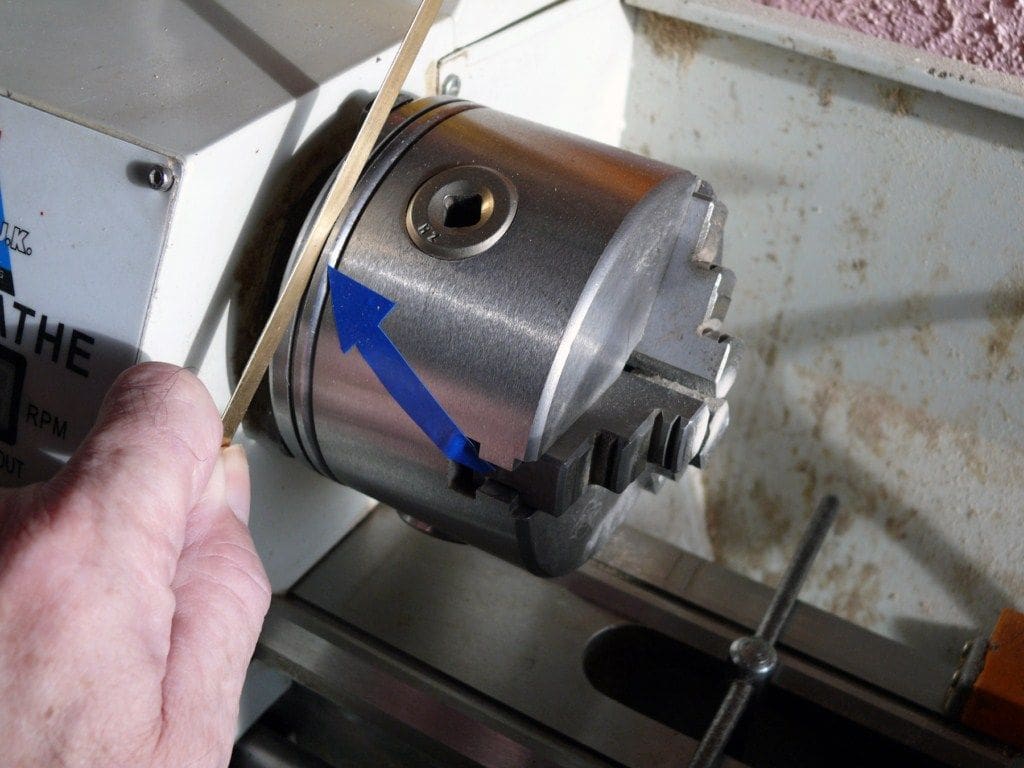
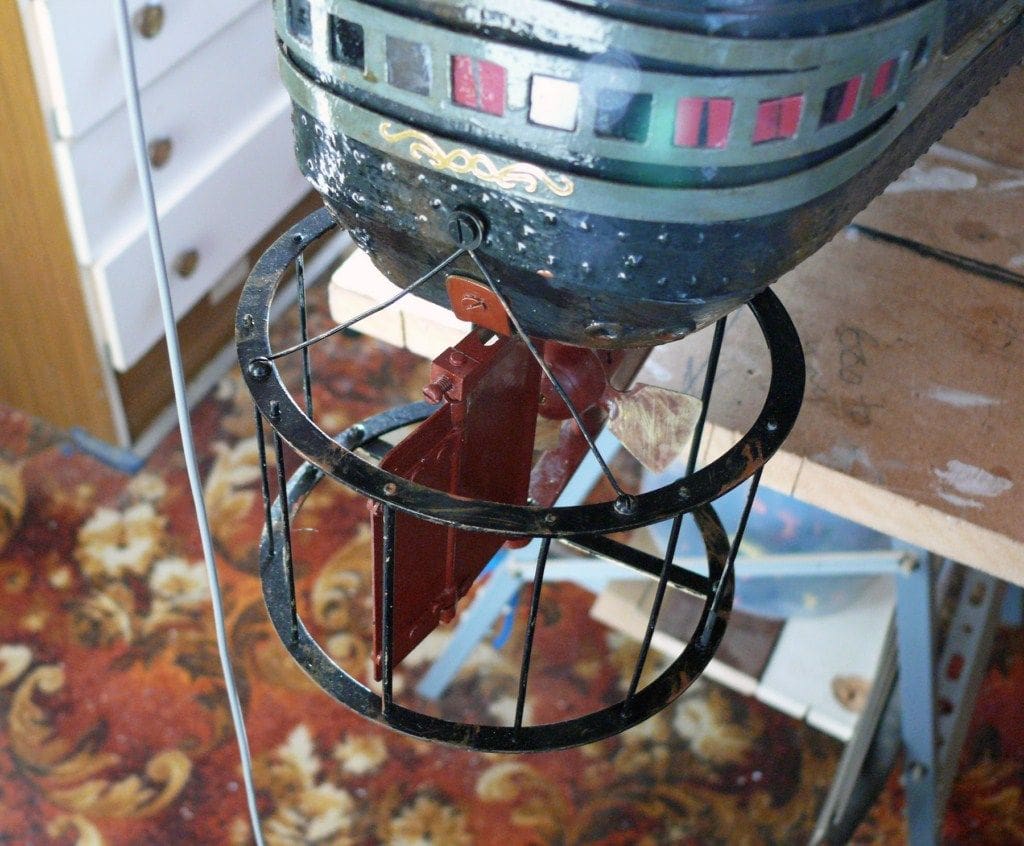
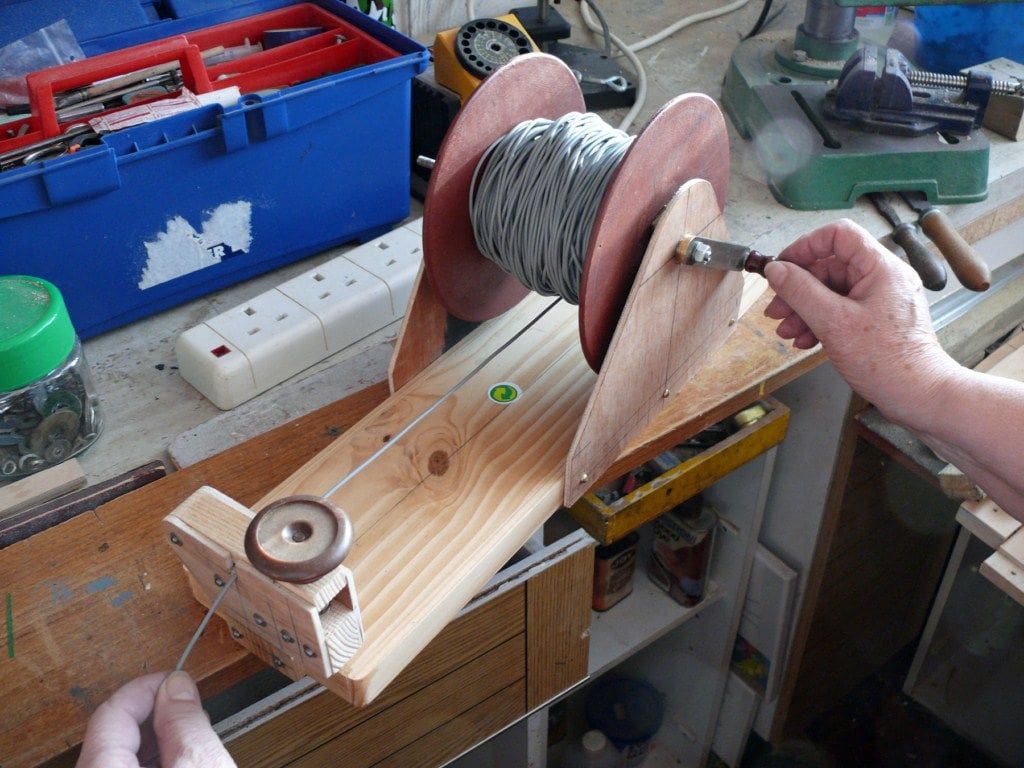
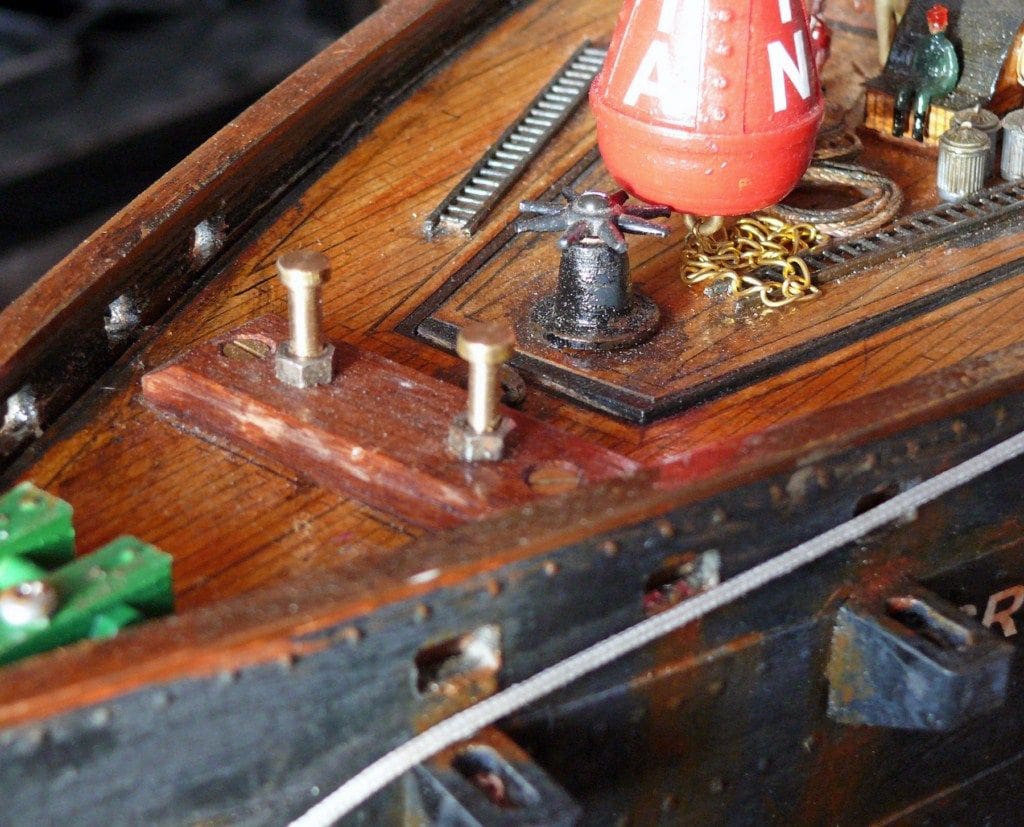
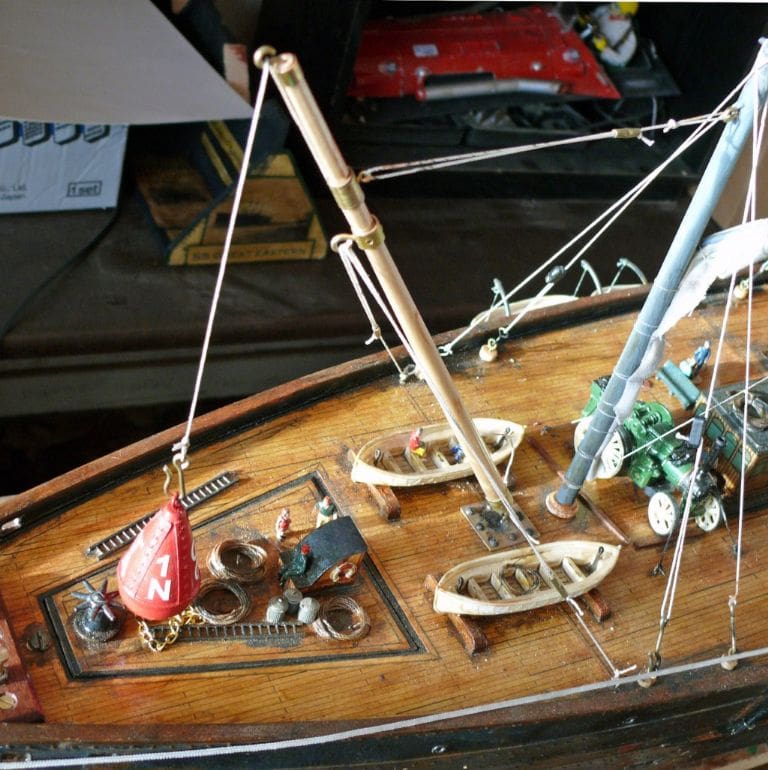
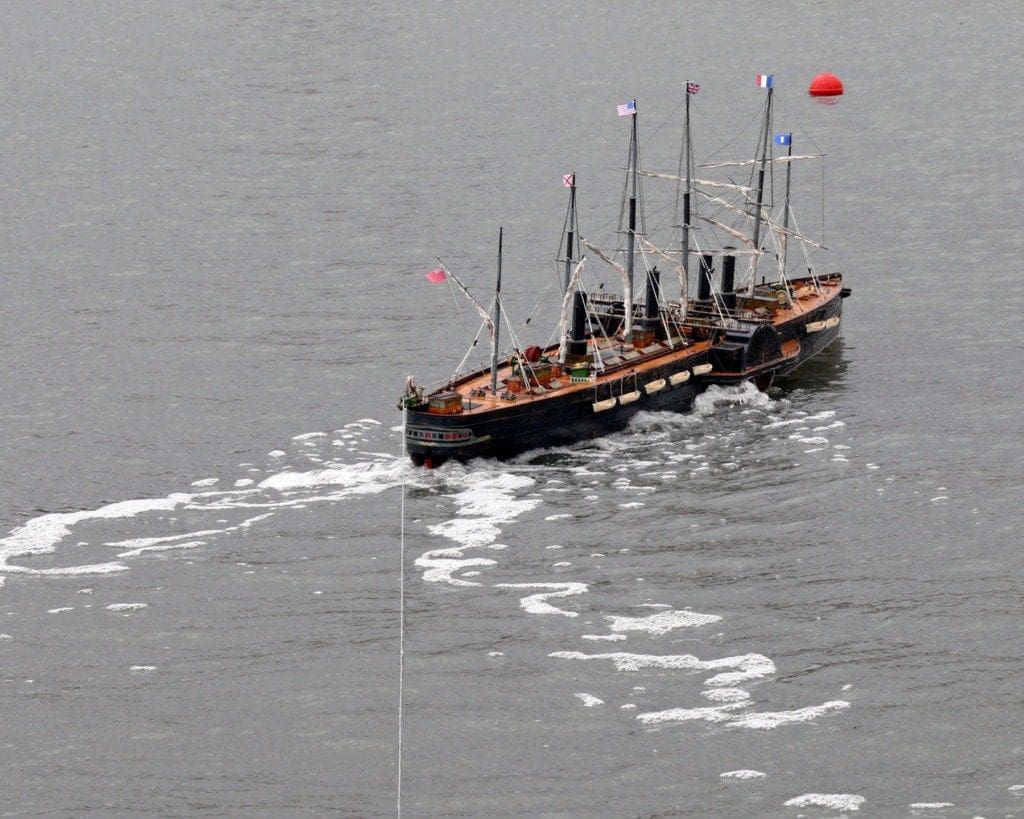
Deck modifications
The first items to be built were the cable handling winch and the paying out sheave at the stern. These items needed to be quite robust, in case the cable snagged, and a visual indicator was also required to show on film that the cable was actually being paid out as the model crossed the Atlantic Ocean (aka New Brighton Pond!). This consisted of a brightly coloured pulley wheel that was fitted to the side of the paying out sheaves and rotated as the cable was paid out, which worked very nicely.
Some means was also required to rewind the cable on to the drum after use, since the cable laying exercise might well require a few retakes. The rewinding winch itself was a simple frame with a square driving device on the handle which engaged with the drum core.
For a better visual effect, the BBC experts requested easily accessible terminals on the bows of the model, to which crocodile clips could be connected on reaching that far shore. This meant that the cable drum had to have live slip rings (to convey electricity) between the drum and the terminals.
Underwater modification
I noticed on one of the etchings of Great Eastern when as a cable laying ship, that the rudder and propeller area was protected by a parrot cage type of guard to prevent the cable from snagging, so this was something else to be done. The cage rings were made from thick brass strip hammered into shape using a groove turned into the lathe chuck flange. This cage was actually larger than true scale, as the model has an oversize Becker rudder fitted for improved manoeuvrability.
Initial trials
A cable laying trial was held in June 2011 on the Etherow MBC pond, coinciding with their National Lifeboat Weekend event. The BBC had also confirmed that New Brighton Pond was to be used for filming and a dummy run proposed for later on at that facility prior to filming.
On the day of the initial trial, there was a strong wind blowing and the pond magically seemed to have doubled in length. The model set sail against the wind, but was struggling and halfway across was being blown very noticeably to starboard and would not answer the helm owing to the tension of the cable. On the full size ship, the cable was paid out by the winch and allowed to sink below the waves, but here the cable was constantly taut as it was being paid out. So, to get back on course, a length of slack had to be let out, then the model could recover its intended course. On the return leg of this voyage, the now surplus cable was manually coiled into a hank at the pondside, which was fine until we then tried to rewind it onto its drum on the model, which proved difficult because it had now developed an inbuilt twist. (A bit like garden hoses that never seem to coil up properly after use – Editor)
Anyway, some pictures of this first trial were posted on the MB Website Forum for light entertainment!
Second trial
In early August we had another sea trial, but this time the BBC Coast team were present to plan their final filming session and to check the New Brighton Pond and local area. Despite the initial unruly weather, we had a good day.
Great Eastern was placed in the water, much to the delight of the advance guard from the Coast Team, who being unfamiliar with radio controlled model boats found it all rather exciting as we sailed around whilst they took a few pictures to show the rest of the staff back in Birmingham.
Fortunately the weather improved and with the model in the water, the cable drum was placed in the hull and the cable threaded through the system to the payout sheaves. The Coast Team liked the visual rotation indicator which rotated when the cable was pulled through. The cable was anchored to a nearby safe spot and the circuit was checked for integrity.
Horror of horrors, no circuit! The hasty installation of the drum in the model was the problem and yes, access was limited and the circuit making button compressing the drum assembly to make contact was of course on the seaward side of the model.
Anyway once solved, we set off. The strain on the cable was still quite high, but we struggled across the lake, making slow progress with much churning up of the water. It was discovered later that the rim brake, which keeps tension on the cable, was jammed under the cable drum which explained a lot. Anyway, finally Great Eastern reached her destination. The bow terminals easily enabled a quick connection of crocodile clips, the circuit was checked with a meter and to our delight it all worked.
The final test was with the galvanometers. There was one at each end of the wire and when the current was passed down it, a mirror built inside a coil moved to the left or right. A lamp beam was projected at the mirror and the reflection was projected on to a white screen. The right and left positions of the light corresponded to ‘Dot’ and ‘Dash’ in Morse Code. That concluded the trials and after a few more photographs we departed New Brighton.
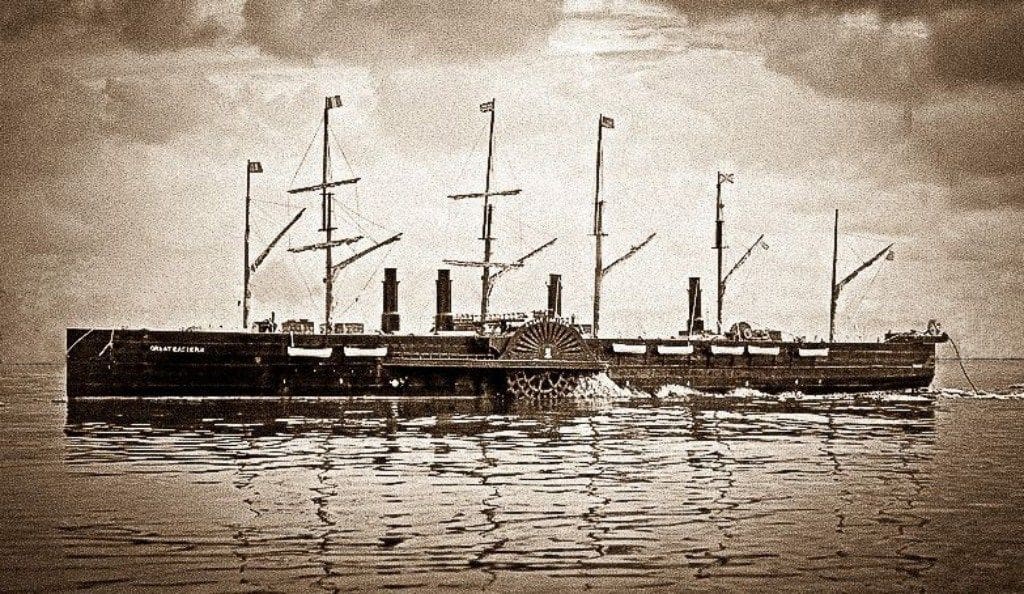
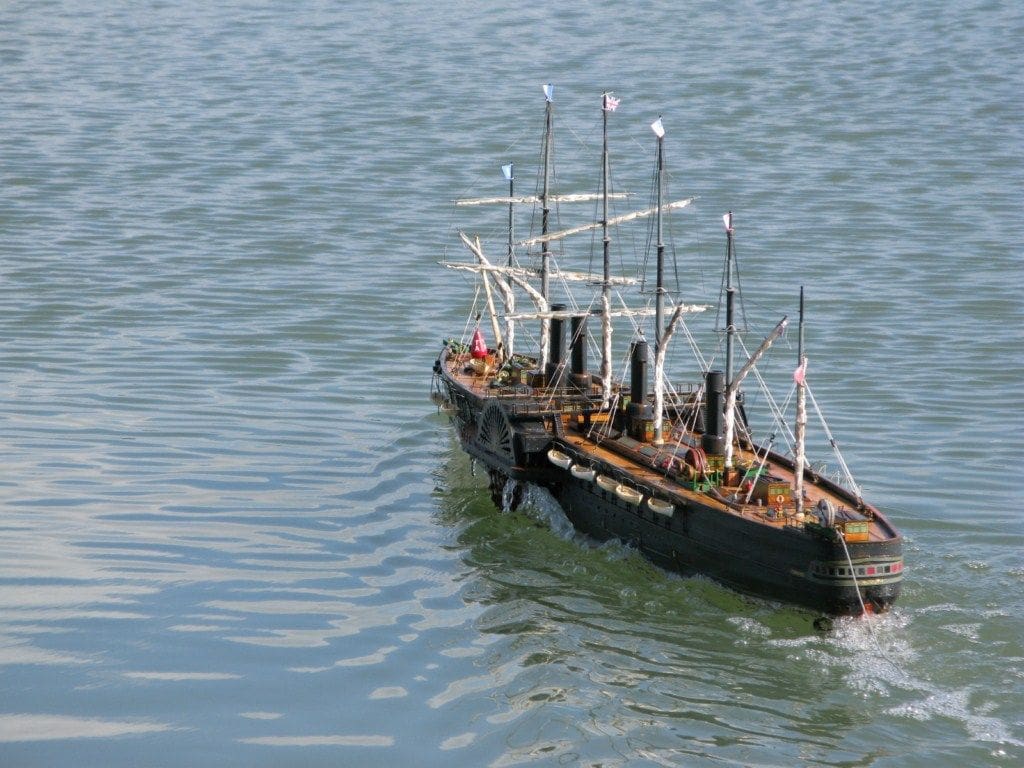
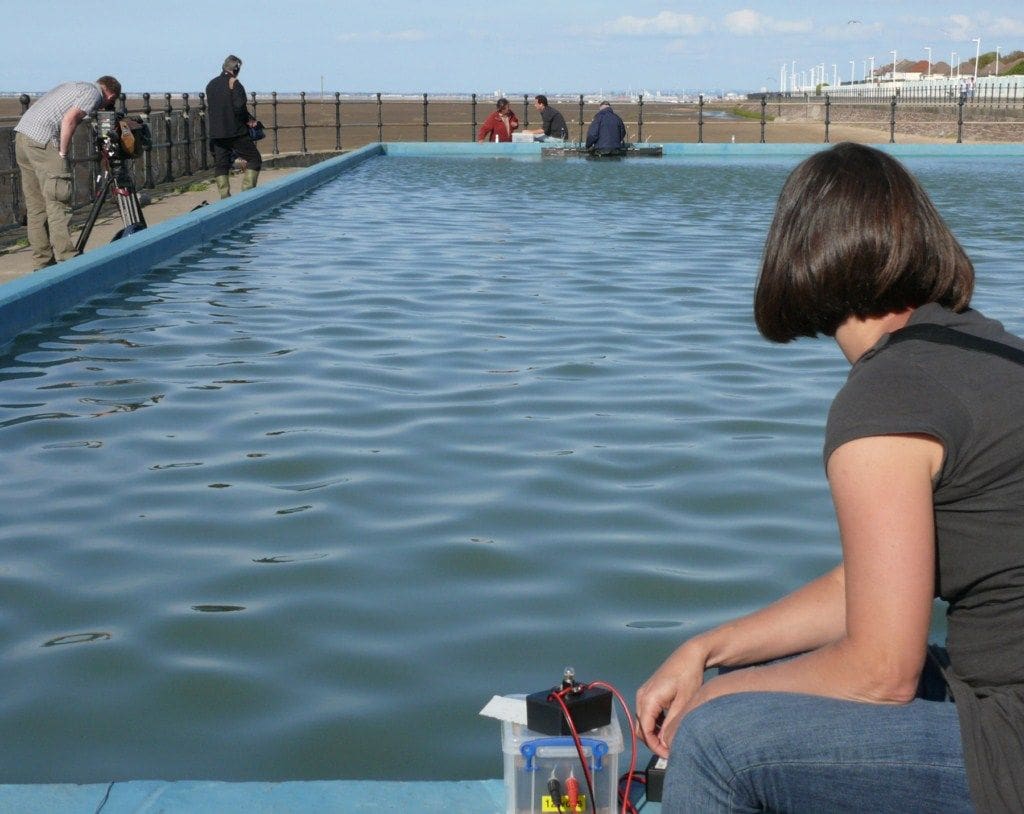
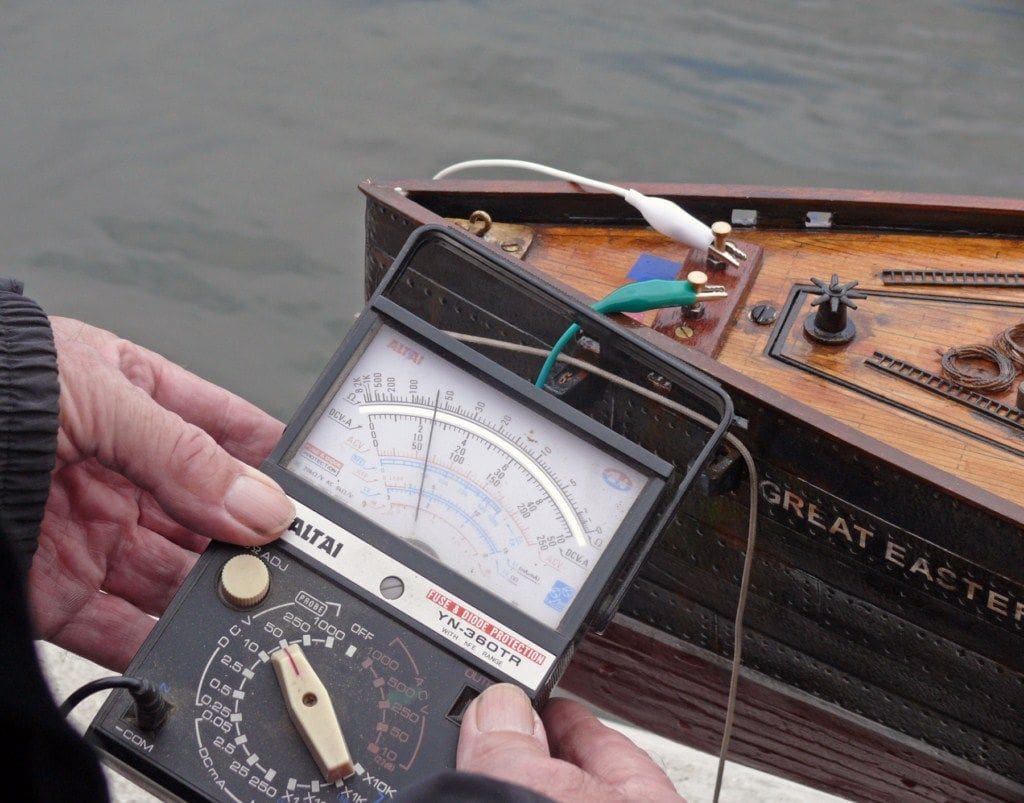
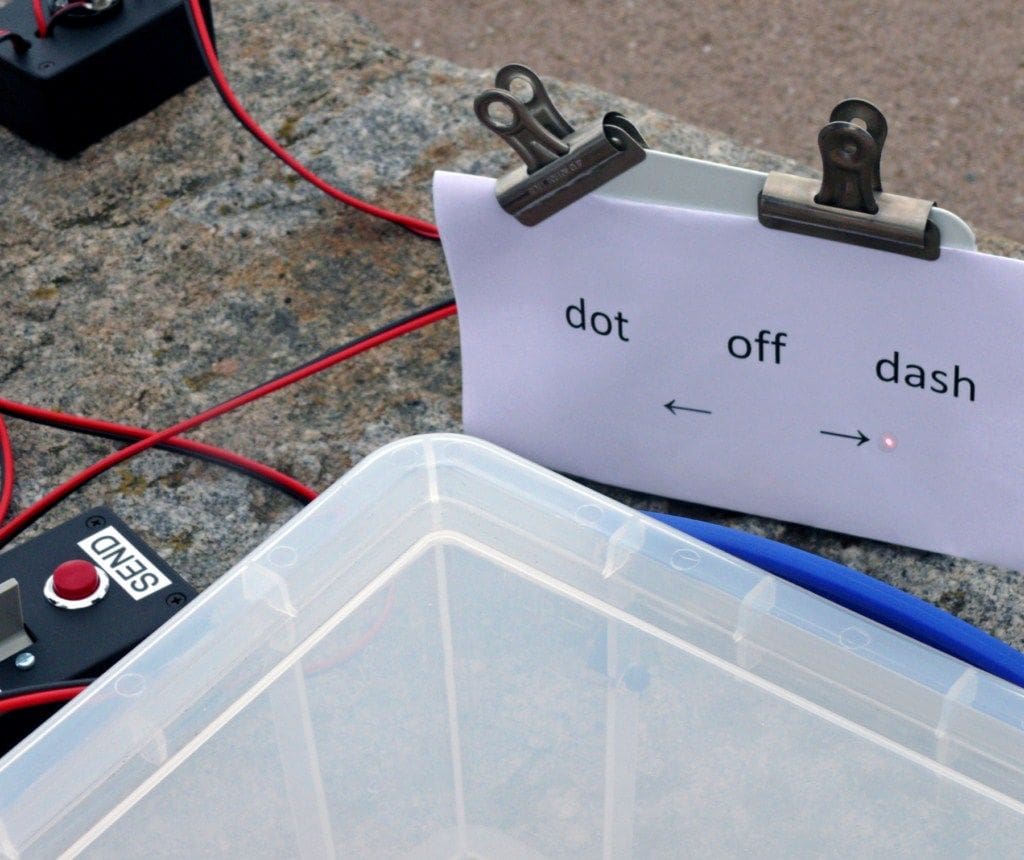
All change
A few days later, the Coast Team decided that the New Brighton Pond was too close to the road for their sound experts and they were considering using another water at Hoylake. Also, one week before filming was due, I decided that the broken cable episode deserved an addition to the model. So. a crane and giant red buoy supplemented the grappling equipment mounted in the bows.
Filming – 22nd August 2011
We arrived at Hoylake early and met up with regular Model Boats correspondent Dave Wooley, who would be taking some photos on behalf of the magazine. (December 2011 MB – Editor).
The day was beautiful with bright sun and no wind, thus a perfect start to this memorable day. Hoylake MBC had put up their club banners and hoisted the Union Jack and the Stars and Stripes to signify the occasion, namely the joining of Europe to the United States of America.
The BBC Coast Team rolled up in convoy and unloaded their mountain of equipment. It was good to meet the members of the team face to face after all the months of phone calls and emails and extremely nice to meet Mark Horton, the presenter on this occasion. Filming soon started with close ups of Great Eastern and a few cruises round the lake to give the camera team time to get settled in. I was a bit taken aback when the soundman wired me up, as I was expecting not to have a speaking part and the next minor shock was, ‘Get these waders on Bob, you’re going in the water’.
The first filming session was discussing the model with Mark Horton, which was very exciting, but my vocal contribution was actually rather low key. That session ended with Mark Horton happily sailing the model around the lake.
The next filming session was the opening scene with an animated Mark Horton waving the flags, myself and brother Geoff holding a very heavy Great Eastern, together with Dr. Jonathan Hare holding his precious galvanometer in front of the Crosby Brass Band. After the opening announcement, we had a few confetti bombs go off which made rather an embarrassing mess on the beach.
The film crew then stayed on the beach for what seemed like forever, doing something with the band and filming another milestone in history, namely the first ever 1858 trans-Atlantic cable laying attempt when ships set sail from both the UK and America and then meeting in the middle of the Atlantic. Apparently the cables were successfully joined, but the voltage was incorrect and the connection burnt out, thus bringing that attempt to a rapid end.
After a somewhat late lunch, the film crew set up their equipment for the final scene with Great Eastern performing the cable laying at nearly 4pm (1600hrs). Of course, a wind had now developed which rather begged the question as to why the cable laying voyage wasn’t done in the morning when it was calm!
The UK base was set up with the Coast Team cable laying expert Cassandra in charge and the cable safely anchored to the pond edge. So at last, Great Eastern set sail for Newfoundland (the other side of the Hoylake MBC pond), but the wind force was now severe and we were blown off course. At one point, the cable snagged on a marker buoy, but Captain Bob (me) equipped with waders ventured into the ocean to recover the cable with a five pronged garden hand claw. So yes, we cheated, but only just a little bit!
For this final voyage, the paddle drive packed up as well, since the motor shear pin had done its job and broken. With no time to stop for repairs as time was running out, we ploughed on with only propeller drive and steamed into Hearts Content, Newfoundland (the other side of the pond), to rapturous cheers and applause from the camera crew. Of course, Joe Public had all now gone home ………..
As mentioned before, the cable drum inside the hull has live slip rings and to make sure the signal was continuous I had to press a button on the seaward side of the hull to ensure the circuit was maintained, hence waders and more than an hour in the water. Dr Jonathan Hare had his galvanometer stuff all set up ready and connected the cable and it all worked – hooray!
The galvanometer detected the current which energised a coil, inside of which was a pivoting mirror. A laser beam was shone on to the mirror and the light beam was further projected on to a white screen which had three marked positions:
Dot – Off – Dash
Back on the British side of the Hoylake Pond, Cassandra was operating the transmitting unit. A message was sent via the cable to the galvanometer, which translated the signal into dots and dashes. Dr. Hare read out the Morse signals and translated them into alphabetical letters and Mark Horton wrote them down to form the message, C.O.A.S.T. What a surprise!
This same scene was repeated about ten times, before Jennie the producer, declared the filming session was over after virtually a twelve hour working day. Never say that film crews have it easy…..
On the following day, the Coast Team went to Rockferry where Mark Horton had arranged for a class of students to investigate the remains of Great Eastern still lying on the mudflats.
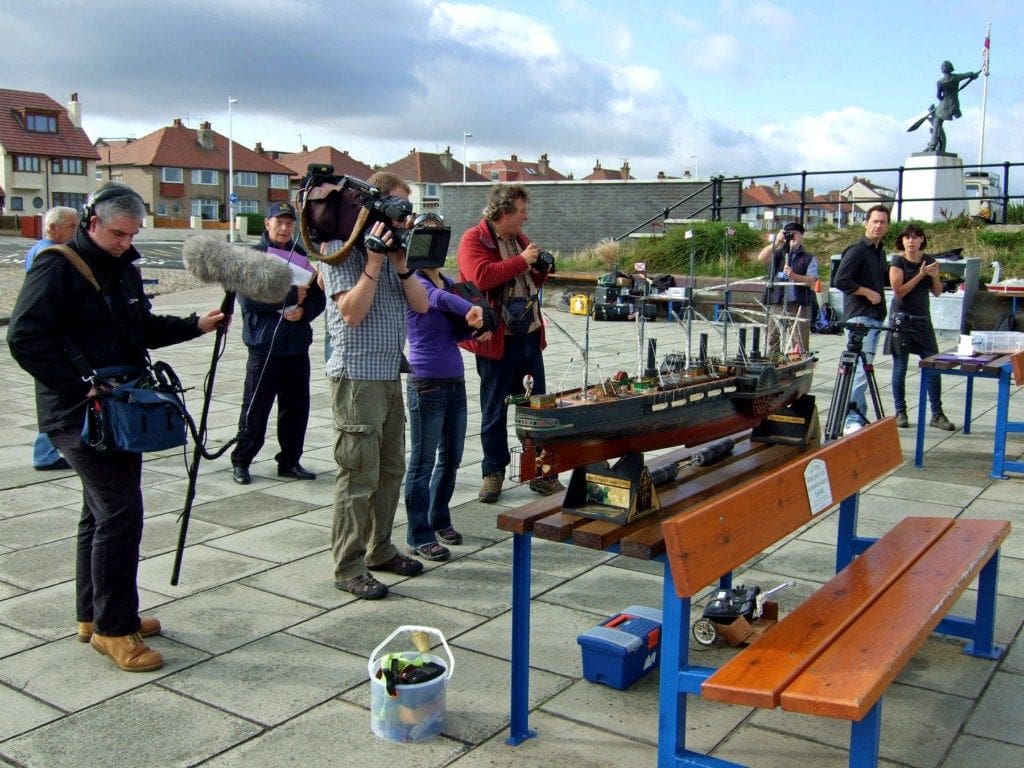
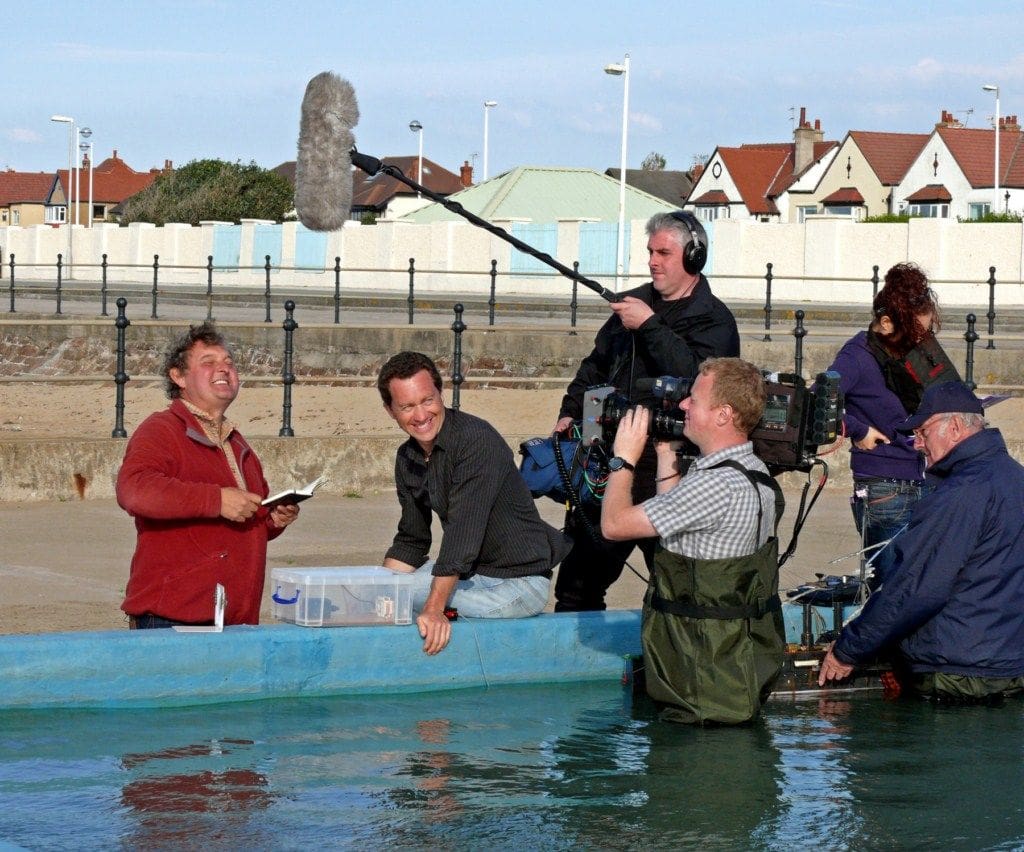
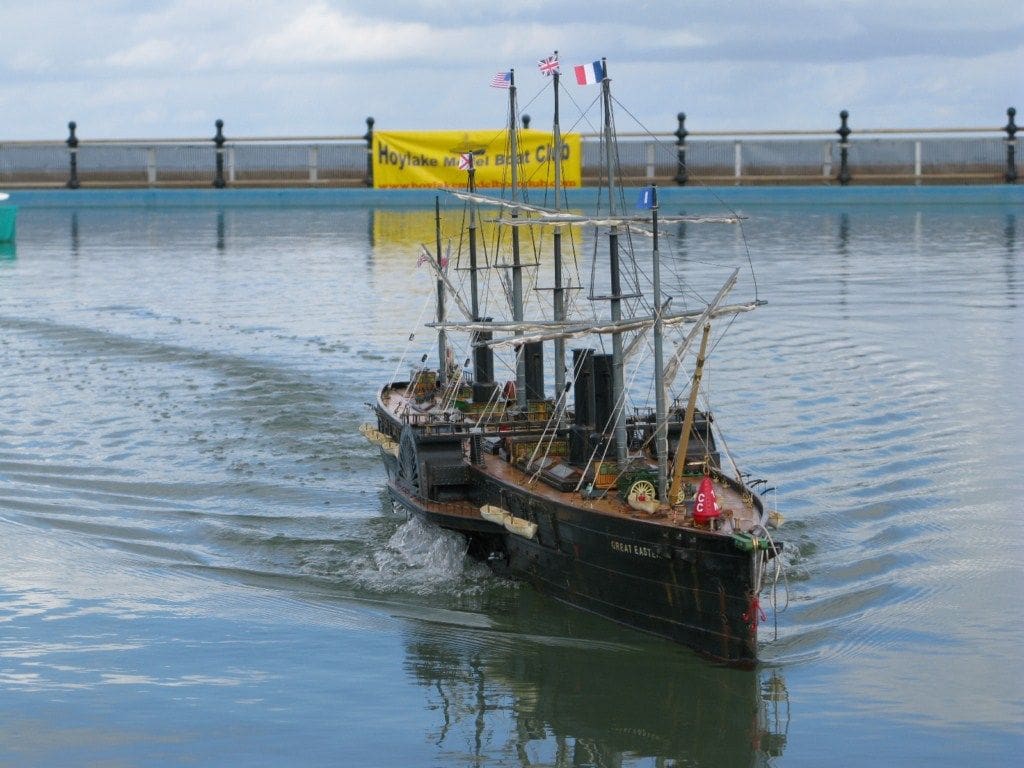
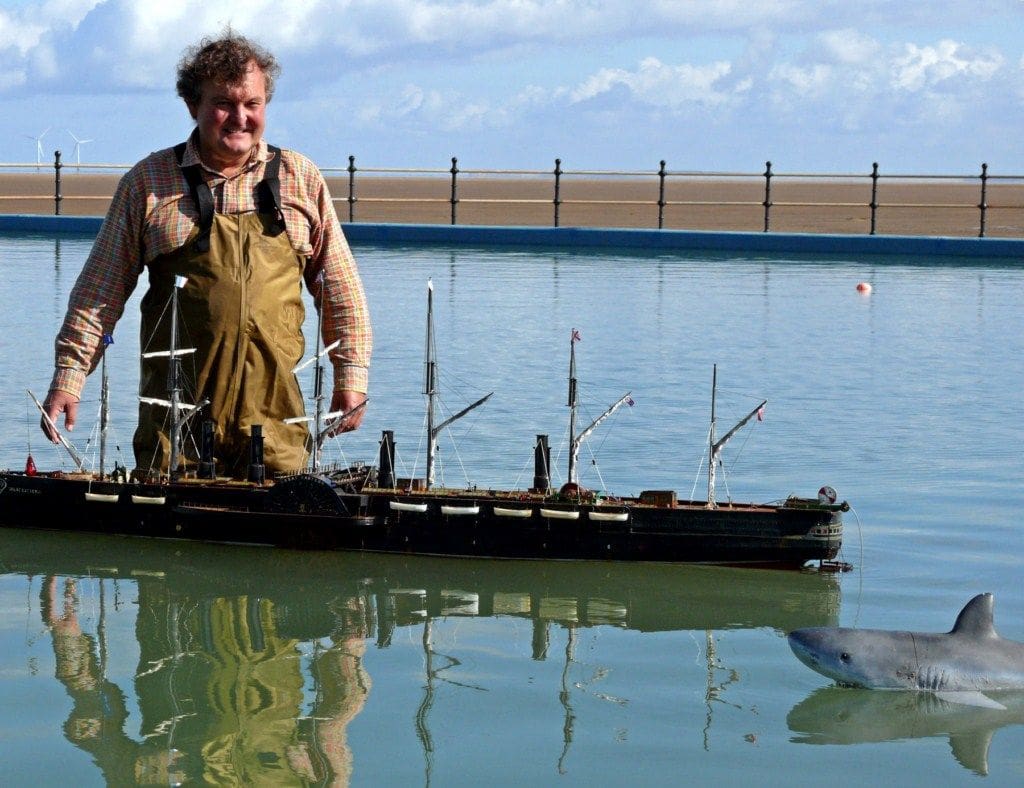
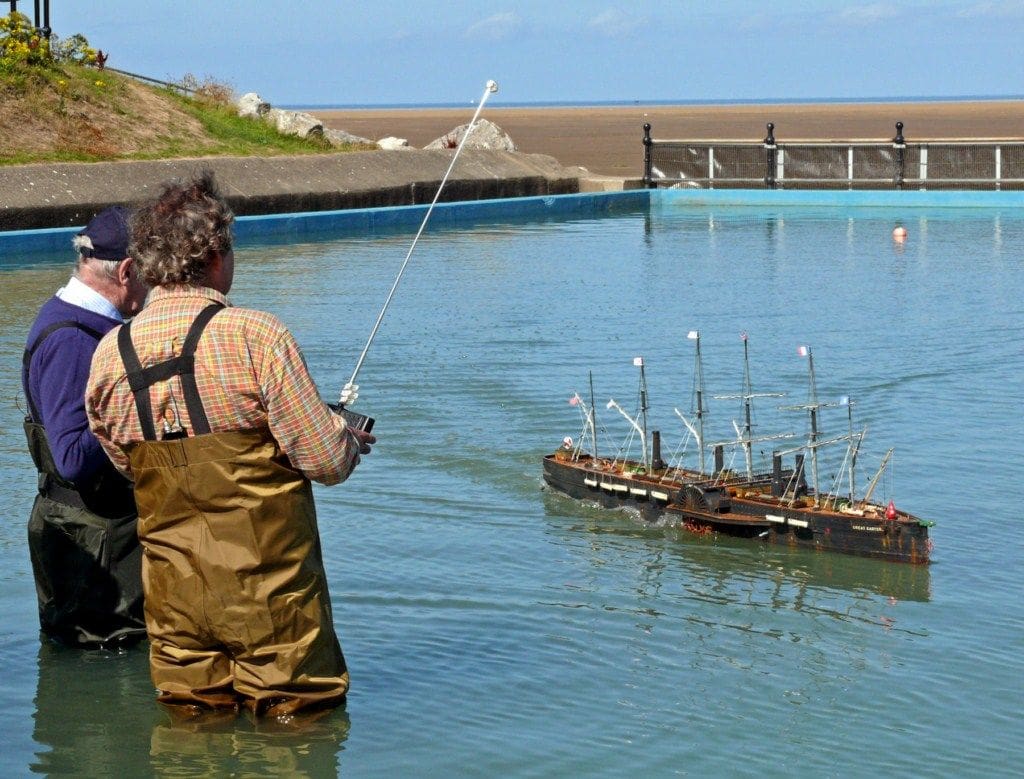
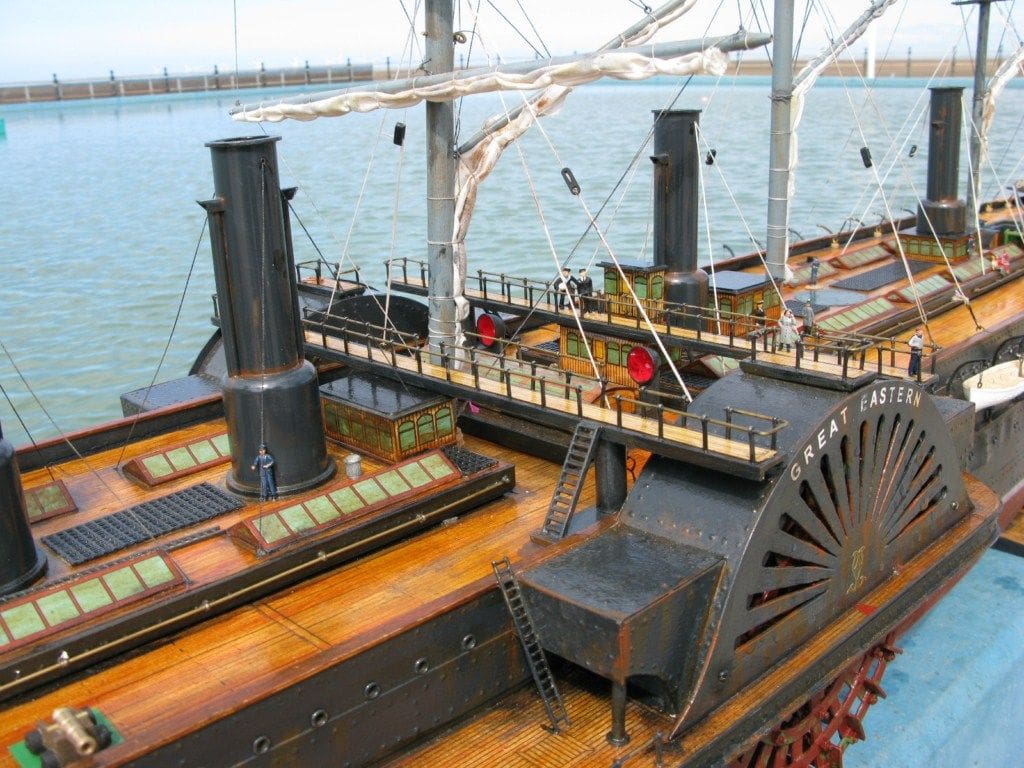
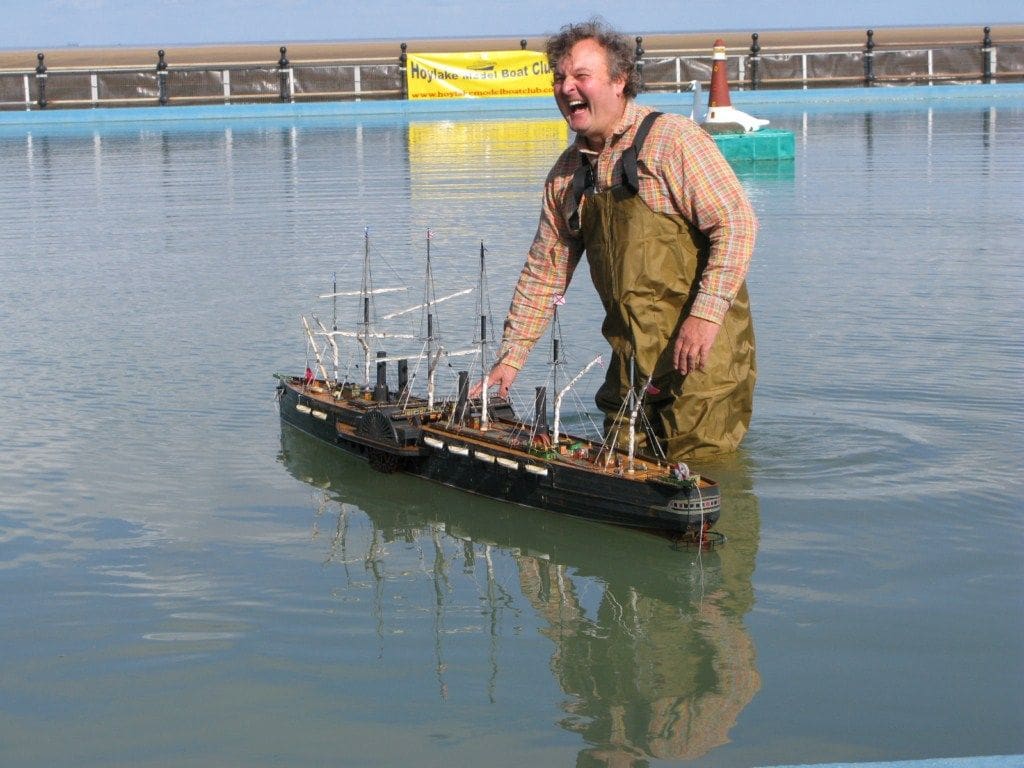
Conclusion
We had a truly magical day, full of interest and excitement, meeting the Coast Team crew and of course Mark Horton himself.
The BBC Coast Team included Jennie, Anna, Cassandra and Jonathan Hare, plus the camera crew, other support staff and of course Mark Horton. Hoylake MBC supported it all magnificently and thanks to Dave Wooley, my brother Geoff, and the Crosby Brass Band for their contributions.
Finally, thanks to all the Model Boats Website Forum members for their advice and constructive comments and Colin Bishop in particular for his help and encouragement, both directly and on the MB Website Forum.




